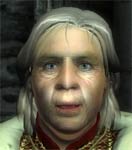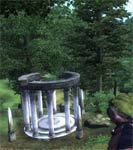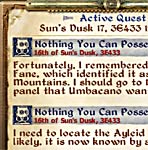Oblivion
Brief Description of Oblivion
| Combat type | Real time with pause allowing |
|---|---|
| Character Summary | Single character, can custom build as you like |
| Play mode | Single player only |
| Game Controls | Combination of mouse and keyboard controls |
| Revitalise character | Potions or sleep or praying at the local temple |
| Quests | Many quests throughout the game. Quests may be related to the main plot, one of the guild plots or one of many NPC related quests. |
You begin the game locked in the Imperial Prison. After listening to your fellow prisoner across the hall, you are ordered to stand back. The Emperor himself comes through your cell to enter a secret passage. The Emperor recognises you from a dream and you are allowed to leave the prison via the secret passage.
The world you will find yourself in is a large complex place. There are eight cities, several small villages, and many caves, ruined forts, elven ruins and old mines scattered across the landscape. The game is also very open ended. Opponents that you face in various places are leveled to be challenging whenever you decide to explore this area or pursue a quest. Most quests you can accept at any time and your quest log will record the information. In fact coming out of the Imperial Prison, you will be set your first task by the Emperor, but you don't need to rush off and do this the moment you find yourself out of the prison.
The game features an absolutely gorgeous 3-D world. The wind ripples the water, and ripples through a field of flowers realistically. The NPCs (non-player characters) are much more lifelike than the average RPG. You'll find them wandering around, gossiping with each other. They have times to open their shop (if they own one), go to eat, go home to sleep, etc. In other words, it feels much more like a real world since the other people there do things whether or not you happen to be present. Even a creature, like a mountain lion, can be spotted grooming like any cat.
Oblivion is the fourth of the Elder Scroll games, previous games being: Arena, Daggerfall and Morrowind. Each game is a stand-alone entity, so having played other Elder Scrolls is not needed to start Oblivion.
Game play and hints
Building your character
Oblivion has one of the most detailed character builds that I've ever seen. When just starting the game, you must select a race from one of the 10 races of Cyrodil. Each race has bonus abilities and natural inclinations. Gender plays a small part as well, male vs female makes a small difference to starting stats. In general, your character should be geared toward one of three major specialisations; Combat Arts, Magic or Stealth. Choose a race that is well adapted to the specialisation you wish to try. In addition to race, you'll have to select a birthsign for the character (you'll be asked about this after you've been following the Emperor for a bit). Birthsigns also give some bonuses, it is good to choose one compatible with the character type you are building. Finally you have to chose a class for your character. There are 21 predefined classes, and all the information about a class is shown when you are pondering the choices. The other option is to custom build a class. If you've played Morrowind or have spent some time in Oblivion, this option may be the most appealing. You'll be walked through the precedure so it's fairly easy to do.
Choosing the right class is vital for this game. Oblivion levels a character based on gains in skill points in the primary skills. If you took as primary skills 'Hand-to-Hand', 'Blunt' and 'Blade', then only used Blunt, you'd be adding to your Blunt skill but you would level very slowly because you have two primary skills you don't use. You need to get 10 points improvement in primary skills to advance to the next level.
Just before you leave the beginning dungeon, you'll be allowed to change every aspect of your character. Save the game here and you can start a new game without having to do the beginning dungeon over again. I like that you do get to explore for some time before you have to finalise your character. You may still find that it's necessary to abandon your first character and build another more suited to your game style once you've explored outside of this dungeon for a while.
Skills
Skills have overall levels; novice, apprentice, journeyman, expert and master. A novice at a skill has almost no ability to perform that skill at all. As you improve in the skill and move up a level, you gain skill perks. For your primary skills, you want to get to journeyman and get those skill perks as quickly as possible. For combat and stealth skills, these will be bonus abilities. For magic, you can use much more powerful spells at the new level.
Interface
The main interface can be accessed at any time by pressing the tab key. Buttons along the bottom of the screen allow you to access full character details, inventory details, magic and finally the quest area. Each of these tabs brings up more tabs. When I first started playing, I missed that the three color bars on the left and the compass on the right were buttons.
The two tabs I use most often during the game are: the inventory and the maps. The Inventory is split into All, Weapons, Armor, Alchemy/Potions, Scrolls/Stones/Miscellaneous. The map button also accesses the quest logs (active, current quests and completed quests.) You can switch any of your current quests to be the active quest. The advantage to that is that the active quest highlights important areas on your maps.
The game uses keys to walk in any direction, rest, cast spells, etc. You use the mouse to turn your character in the direction you want to travel or just to look around.
(more on page 2)

